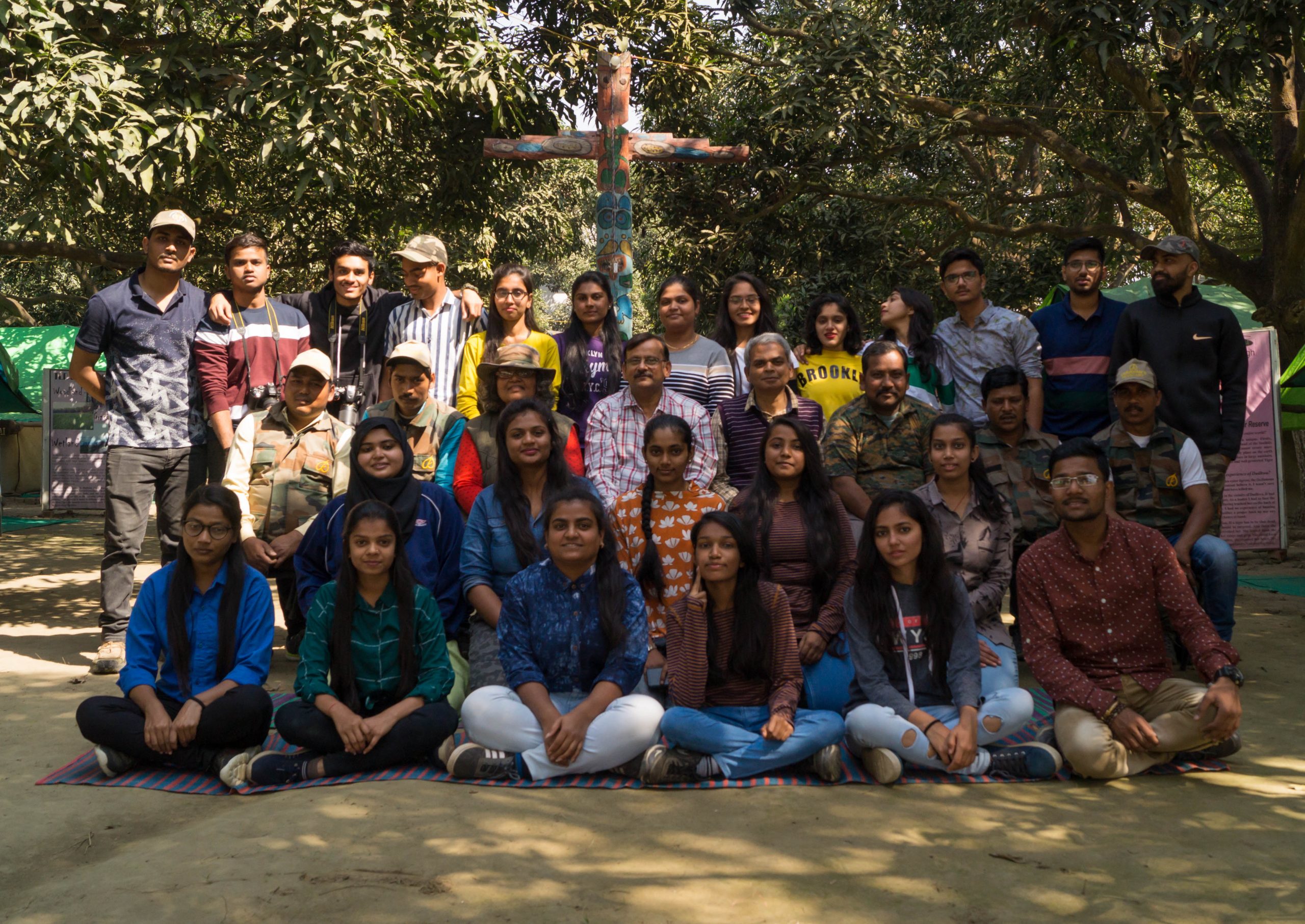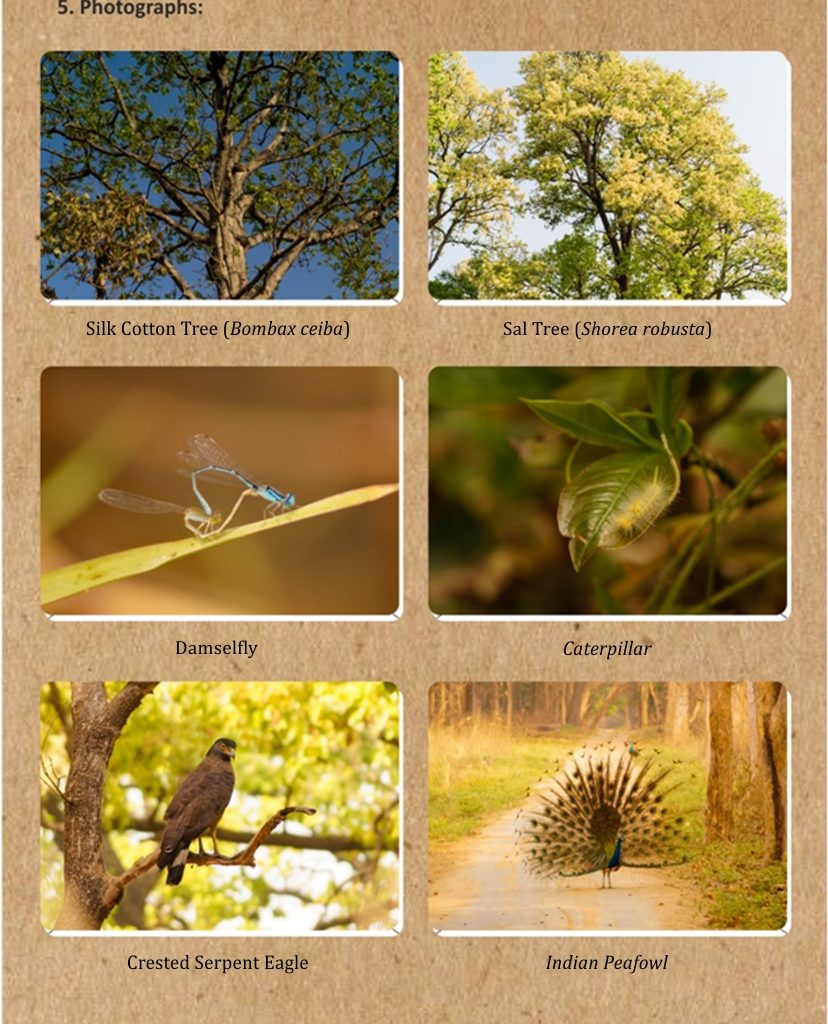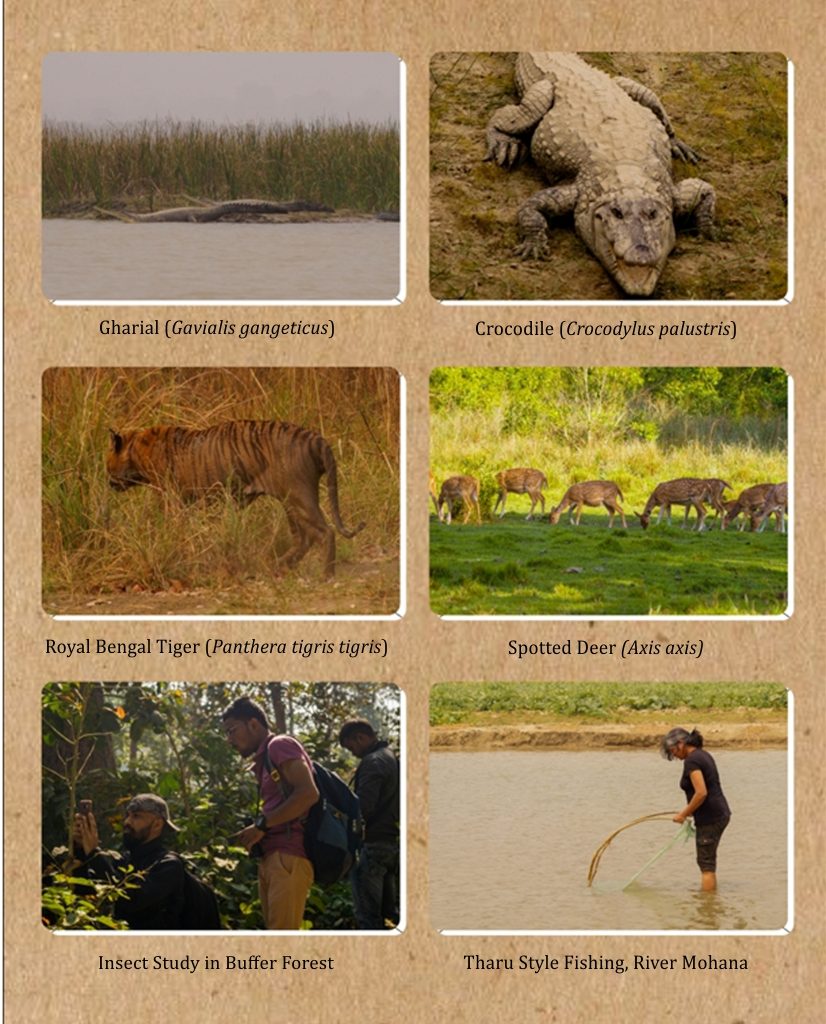
Karavan’s Field Study Camp
Naturalist’s Eye
Dudhwa Tiger Reserve
INTRODUCTION:
Dudhwa Tiger Reserve, District Lakhimpur Kheri (Uttar Pradesh), is the best-preserved forest of the Terai Arc Landscape. The Terai Arc spreads across the southern edge of the Himalayas in India and Nepal.
These are some of the activities designed by Karavan Heritage and Nature Society at Dudhwa for Research Scholars, PG and UG students from the fields of Environment Sciences, Life Sciences, Geology, Geography and Social Sciences.
- Explore and study different habitats of Dudhwa Tiger Reserve
- Document the floral diversity (herbs, shrubs, trees, creepers and medicinal plants) of Dudhwa
- Explore the zoological diversity of Dudhwa (insects, fishes, amphibians, birds, mammals and endangered species)
- Analyze the existing forest and wildlife conservation model
- Go on a simulated mission to track and trap a man-eating tiger in the forest
- See for yourself how forests are managed, how people live in harmony with nature and what are the causes of man-animal conflict
At Karavan’s Field Study Camp, we explore and study the jungles of Dudhwa and Terai Landscape in totality. We shed light upon its geography: Rivers, Habitats and Natural Phenomenon; Biology: Flora, Fauna, Endangered Species and their Conservation Status; and we also delve upon the human dimension: Forest Management, Communities and Man-Animal Conflict. We also encourage participants to join us in our mission to conserve Dudhwa forest at a micro-level.
INDEX:
- Participants and Participating Institutions and their objectives
- Scientific objectives of camp
- Camp Methodology
- Outline of Dares (Activities)
- Some Memorable Moments
- Resource people
- Summary
- Annexure of Field Work:
- Flora
- Invertebrates
- Vertebrates (Fishes and Amphibians, Reptiles, Birds, Mammals, Endangered Species)
- List of Evidences of Zoological Life forms
- Photographs
- Videos
- Student Participants of B.P. Baria Institute of Science
PARTICIPANTS AND PARTICIPATING INSTITUTION AND THEIR OBJECTIVES
PARTICIPATING INSTITUTION:
B. P. Baria Science Institute, Navsari, Gujarat
Name and Designation of Faculty Member:
Dr. Alkesh I. Shah
Professor and Head of Department- Zoology
Number of Students: 24
Date of Camp and Duration: 23rd– 26th February 2021/ 4 Days Duration
Objectives:
Conduct an extensive Field Study of the zoology of Dudhwa, as a part of the curriculum.
INDIVIDUAL PARTICIPANTS
- Ms. Poornina K.P, Landscape Architect, Bangalore, Karnataka
- Ms. Sunitha, Biology Teacher, New Horizons School, Bangalore, Karnataka
Date of Camp and Duration: 2nd– 7th April 2021/ 6 Days Camp
Objectives:
- To eyewitness the Terai landscape and correlate it with a priori academic information,
- To observe and document the endemic flora and fauna,
- To formulate an effective communication to educate students about the environment and conservation.
METHODOLOGY
The Methodology of Field Study adopted at the camp is as follows:
- Thorough briefing about the place/location/specimen that is to be explored with the help of maps, sand model, informative displays and forest interpretation centre
- Access to information from authentic sources (books, forest management plans and government gazettes)
- Direct observation with help of binoculars and consultation with guides
- On-the-spot Documentation and photography
- Specimen/sample collection (wherever permitted)
- Cross-checking of data with authentic references and sources
DARES (ACTIVITIES):
- Dare Selfie 2 Science:
The first activity is done to explain to our campers how a smartphone is a handy and powerful tool to capture, document and study the natural world. Campers are told about the techniques and methods of handling smartphones and utilize them for scientific documentation.
- Dare Sal and Pal:
Campers orient their way through the jungle on foot, exploring the different habitats of Dudhwa: wetland, grassland, woodland, riverine forest and farmlands accompanied by experienced naturalists. Campers experience a real forest as it actually is. They are apprised about the unique flora of each habitat and how individual components are interdependent.
- Dare Terra- X:
Through a lively story-telling session, Campers are informed about the Rhino Rehabilitation Project. Executed under the supervision of the Founder-Director of Dudhwa, Dr Ram Lakhan Singh, rhinos from Assam and Nepal were re-introduced at Dudhwa to create a new habitat for their survival. Campers analyze various aspects of this project and reason out whether this project is a success or failure.
- Dare Aqua Life:
The central task of this dare is that Campers have to first design a typical Tharu Fishing Net; then wade into the river Mohana, which demarcates the Indo-Nepal geographical boundary. With the aid of their fishing nets, campers collect various aquatic life forms; algae, submerged plants; invertebrates: water beetles, dragonfly nymphs, molluscs; and vertebrates: small fishes, tadpoles and frogs. All collections are photographed and released back into the river. The presence of diverse aquatic life in Mohana reveals the purity of river water in Dudhwa.
- Dare I-Witness:
Campers are taken for a 3-4 hour long guided jeep safari into the core forest where they visit different ranges at the reserve: Dudhwa, Sonaripur, Kishanpur and Katerniaghat. They experience it all: the majesty of the Sal Forest; the confusing jungle tracks; the termite hills; the views from the machans (watch towers); the huge wetlands; the migratory and resident water birds; the grassland; rivers Suheli, Sharda, Ghaghra and Gerua; they get to know about the Rhino-Rehabilitation project, the swamp deer; Gangetic dolphin; Gharials and other endangered species whose very existence is possible nowhere else but Dudhwa because of the ideal balance of biotic and abiotic factors.
- Dare Earth Summit:
Campers participate in an imaginary debate between humans and all other life forms. Threatened by sheer human rapacity, life forms hold humans guilty for their woes and strategize on how to teach humans a lesson. Both sides argue their point of view furiously and passionately. This discussion is especially relevant when the entire human race has been rendered helpless by the Chinese virus, despite all scientific knowledge and technological advancement.
- Dare ‘Insect’:
We conduct the study of Arachnids and Arthropods (spiders and insects) at Dudhwa on the banks of a canal passing by the Mailani Range and at the Sheesham tree forest on the northern edge of Dudhwa. The moist soil, dense foliage and several host plants provide excellent conditions for campers to photograph and document a variety of insect species. While students and researchers have an academic interest in arthropods, our effort is to sensitize other people about the rather unexplored world of insects.
- Dare Expedition:
Karavan’s Camp is not just meant for academic pursuit; it also offers fun and adventure. The most popular activity is a simulated mission to track and trap a man-eating tiger in the forest. This dare tests one’s planning, teamwork, ingenuity and time management skills. Armed with binoculars, campers also undertake cycling expeditions in the wilderness to observe the unique floral specimens, enjoy mulberries and sugarcane, watch insects and birds and exercycle on river banks.
- Briefing and De-briefing Sessions:
Prior to embarking on any activity, campers are given a briefing about various aspects of place or object of exploration with the aid of maps/ sand model/ information displays. The complete activity is explained on the Camper’s Manual; which also contains relevant facts about Dudhwa. The camper is, thus, informed in advance about where and how to conduct his fieldwork. And so, the camper’s field perspective is enriched all the more. Later during the de-briefing, the documentation work is analyzed and cross verified with authentic references and sources (books, forest management plans, gazettes). Besides, interesting discussions about the field experience are shared at the evening campfire.
- Environment Conservation:
Ms. Poornima K.P, a landscape architect from Bangalore, has recommended the ‘concept of Up-Van’ or a traditional herbal forest garden to the Karavan team. An Up-Van is a repository of herbal and medicinal plants which hosts numerous fauna: bees, insects, birds and mammals. The indigenous plants in an Up-Van are a much more useful alternative to exotic ornamentals. This concept resonates with Karavan’s ongoing project to create a micro-habitat at our camp.
SOME MEMORABLE MOMENTS:
- Vulture congregation:
In present times, at Dudhwa much like anywhere else, sighting a vulture is a kind of special reward. The zoologists from Navsari are lucky to witness a big congregation of 30 Himalayan Griffon Vultures on the banks of River Sharda. It is indeed the rarest of rare sightings. Perched atop huge silk-cotton trees overlooking the river, these vultures are eying upon a buffalo carcass. Ever alert they are on the watch for dogs and bullish crows, two creatures that always harass them. A couple of vultures reach for the carcass; feed upon it and fly off; as though giving other comrades the opportunity for a feast. Campers are absolutely delighted. Lights, camera and action begin. Other tasks for the day are given a miss for some time.
- Tiger Sighting:
At Kishenpur Range of Dudhwa, a tiger is caught on camera. He has a polythene noose around his neck. The noose has to be removed or else the tiger will meet his death. Rescue parties, consisting of jeeps, elephants and foresters are patrolling every inch of the forest. But this activity has disturbed the entire forest. It has become usual not to see single wildlife during jungle safari. Ms. Poornima and Ms. Sunitha have been at Dudhwa for 5 days and not one big or lesser cat has given but a glimpse of themselves. Will they be lucky today? Lo and behold, they finally spot a tiger near a waterhole. All of us celebrate this entirely unexpected tryst.
- Garba Performance:
Late evening after dinner, our young campers from Navsari wish to perform Garba. Under our camp rules, music is played softly so as not to disturb anyone. Under twinkling lights, the festivities of Navratra come alive at Vasant in the forest. Everyone joins in swaying in perfect coordination to the melodious notes.
KEY RESOURCE PEOPLE:
- Deepti, founder member of Karavan, Camp Leader at Dudhwa.
Deepti is the brain and brawn of our Camp. She has been working at Dudhwa in the field of environment education and conservation for the past two decades. She has immense experiential knowledge of Dudhwa forest and the Tharu Community. She is a great organizer, communicator and educator.
- Anirudh Gupta is our Camp Mentor. He is young and energetic. He is a passionate wildlife photographer. His knowledge of the art and science of wildlife photography is amazing. He knows the camera inside out. And above all he shares his expertise without hesitation.
- Kewal Singh Rana, the most well informed guide at Dudhwa. His has a field experience of 28 long years. He not only knows the jungle like a son of the soil, he communicates its secrets beautifully to both technical and lay people.
- All other guides and watchers at Dudhwa
- Members of the Tharu community
- Entire Karavan Team
SUMMARY:
The Field Study Camp- Naturalist’s Eye has three aspects, namely
- Scientific study, activities, extensive field work and documentation of Dudhwa Tiger Reserve;
- Administrative aspects which include the best of arrangement: creature comforts, homely stay and mouth-watering food; and
- Our personalized approach because for our team, our camper is the most important person.
At the Field Study Camp, it is a pleasure to be with and knowledgeable about the research work of Dr. Alkesh Shah (HOD- Zoology, B.P Baria Institute, Navsari) on fishes. His student, Priyank Kapdi, is carrying his scholarly legacy in the field of entomology. Priyank explained to us the role of insects in a forest ecosystem. Likewise, Ms. Poornima, a landscape architect from Bangalore, connect with the world of trees is to seen to be believed; her keen eyes miss nothing, not a tree, not a leaf not a blade of grass. All campers are disciplined, punctual, committed and cooperative. In a brief span of time of just 4 to 5 days of interaction, we and our campers have been mutually enriched about Mother Nature. We vow to protect her.
ANNEXURE OF FIELDWORK:
- Flora-
Note- The list of the flora documented is given in alphabetical order with the common names mentioned within brackets.
Achyranthes aspera (Balha Chirchira); Bauhinia blakeana (Bauhinia); Bombax ceiba (Semal); Caesalpinia bonduc (Kanja);
Cassia fistula (Amaltas); Citrus limon (Kath Nimbu);
Clerodendrum infortunatum (Badi Bhat);
Clerodendrum viscosum (Kali Bhat);
Dalbergia sissoo (Sheesham); Eucalyptus; Ficus racemosa (Gular);
Ficus semicordata (Khurhura); Lantana camara (Lantana);
Mallotus philippensis (Rohini); Mangifera indica (Mango);
Morus spp. (Mulberry); Murraya koenigii (Curry);
Neolamarckia cadamba (Kadamb); Orchis mascula (Gander);
Peristrophe bicalyculata (Choti Harjudi); Saccharum munja (Munj); Saccharum spontaneum (Kans); Schleichera oleosa (Kusum);
Senegalia catechu (Khair); Shorea robusta (Sal);
Solanum surattense (Uth Katila); Sterculia villosa (Udal);
Streblus asper (Sehore); Syzygium cumini (Jamun);
Tectona grandis (Teak); Terminalia arjuna (Arjun);
Terminalia bellirica (Bahera); Terminalia elliptica (Asna);
Toona ciliate (Tunn); Trewia nudiflora (Gutel);
Water hyacinth (Jal Kumbhi); Wendlandia exerta (Tilka)
- Invertebrates-
Spiny Spider; Jumping Spider; Signature Spider; Wolf Spider and Lynx Spider.
Weaver Ants, Black Ants, Termites, Assassin Bug, Leaf Hoppers, Grass Hopper, Black Beetle, Red Bug and Moth Caterpillars
Water Beetles, Dragonfly Nymphs, Mollusks
- Vertebrates-
- Fishes and Amphibian: Tadpoles, Frog
- Reptiles: Crocodile, Ghariyals
- Birds: Red-Wattled Lapwing, Indian Roller, Stonechat, Jungle Babbler, Pariah Kites, Pea Fowls, Himalayan Griffon Vulture, Stork-Billed Kingfisher, Little Egrets, Ruddy Shelduck, Crested Serpent Eagle, Jungle Owlets, Greater Coucal, Flameback Woodpecker, Rose-Ringed Parakeet, Red Jungle Fowl, Rufous Tree-pie, Racket Tailed Drongo, Grebes, Black Winged Stilts, Egrets, Herons, Cormorants, Sandpipers, Black Necked Storks, Adjutant Storks, Common Teals, Grey Headed Fish Eagle, Northern Pin Tail, Gadwall, Garganey Teals and Common Coots.
- Animals:Spotted Deer, Hog Deer, Barking Deer, Blue Bull, Wild Boars, Rhesus Macaques, Langoors and Otters.
- Endagered Species:Tiger, Ghariyal, Swamp Deer
- List of Evidences of Zoological Life Forms-
Pugmarks, Pellet Dropping, Hair and Hoof marks, Photographs, Videos and Audio Recording.


- Videos:
- Interview with Dr. Alkesh Shah, HOD, Zoology
YouTube Video Link: https://youtu.be/yltm7cDU2Dk
- Interview with Priyank Kapadi, Entomologist
YouTube Video Link: https://youtu.be/ug72_4p9kXQ
- Interview with Ms. Poornima and Ms. Sunitha
YouTube Video Link: https://youtu.be/Z1DNJsZ8GUc
- Synopsis of Field Study Camp, presented by Deepti, Camp Leader
YouTube Video Link: https://youtu.be/m8E3knuQIqw
- Student Participants from B.P. Baria Institute of Science
Ms. Krupakshi D. Patel
Ms. Krishna V. Patel
Ms. Jahanvi C. Panchal
Ms. Monika C. Sojitra
Ms. Manisha B. Singh
Ms. Mubashshira S. Tailor
Ms. Ashka G Vahia
Ms. Vibhuti S. Nayaka
Ms. Nisha H. Patel
Ms. Jinal H. Patel
Ms. Toral N. Dhimmar
Ms. Ruchui A. Dhimmar
Ms. Priya S. Patel
Ms. Komal Tandel
Ms. Pinal Thakor
Ms. Palla Zaheda
Mr. Priyank Kapdi
Mr. Neel Tandel
Mr. Vaghela Harshit
Mr. Vaibhav Kansora
Mr. Mithlesh Yadav
Mr. Jaidipsinh Deora
Mr. Abhishek Chaudhary

